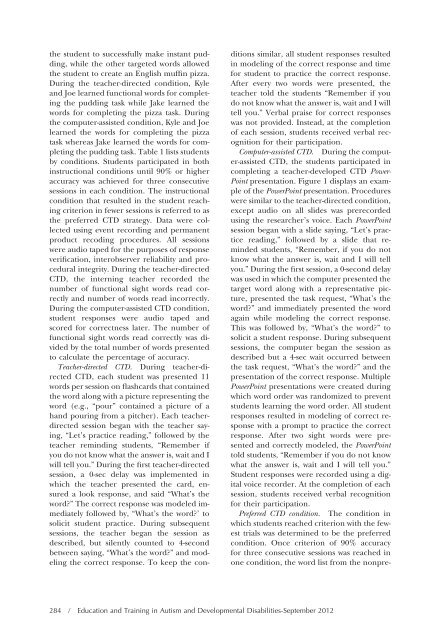etadd_47(3) - Division on Autism and Developmental Disabilities
etadd_47(3) - Division on Autism and Developmental Disabilities
etadd_47(3) - Division on Autism and Developmental Disabilities
You also want an ePaper? Increase the reach of your titles
YUMPU automatically turns print PDFs into web optimized ePapers that Google loves.
the student to successfully make instant pudding,<br />
while the other targeted words allowed<br />
the student to create an English muffin pizza.<br />
During the teacher-directed c<strong>on</strong>diti<strong>on</strong>, Kyle<br />
<strong>and</strong> Joe learned functi<strong>on</strong>al words for completing<br />
the pudding task while Jake learned the<br />
words for completing the pizza task. During<br />
the computer-assisted c<strong>on</strong>diti<strong>on</strong>, Kyle <strong>and</strong> Joe<br />
learned the words for completing the pizza<br />
task whereas Jake learned the words for completing<br />
the pudding task. Table 1 lists students<br />
by c<strong>on</strong>diti<strong>on</strong>s. Students participated in both<br />
instructi<strong>on</strong>al c<strong>on</strong>diti<strong>on</strong>s until 90% or higher<br />
accuracy was achieved for three c<strong>on</strong>secutive<br />
sessi<strong>on</strong>s in each c<strong>on</strong>diti<strong>on</strong>. The instructi<strong>on</strong>al<br />
c<strong>on</strong>diti<strong>on</strong> that resulted in the student reaching<br />
criteri<strong>on</strong> in fewer sessi<strong>on</strong>s is referred to as<br />
the preferred CTD strategy. Data were collected<br />
using event recording <strong>and</strong> permanent<br />
product recoding procedures. All sessi<strong>on</strong>s<br />
were audio taped for the purposes of resp<strong>on</strong>se<br />
verificati<strong>on</strong>, interobserver reliability <strong>and</strong> procedural<br />
integrity. During the teacher-directed<br />
CTD, the interning teacher recorded the<br />
number of functi<strong>on</strong>al sight words read correctly<br />
<strong>and</strong> number of words read incorrectly.<br />
During the computer-assisted CTD c<strong>on</strong>diti<strong>on</strong>,<br />
student resp<strong>on</strong>ses were audio taped <strong>and</strong><br />
scored for correctness later. The number of<br />
functi<strong>on</strong>al sight words read correctly was divided<br />
by the total number of words presented<br />
to calculate the percentage of accuracy.<br />
Teacher-directed CTD. During teacher-directed<br />
CTD, each student was presented 11<br />
words per sessi<strong>on</strong> <strong>on</strong> flashcards that c<strong>on</strong>tained<br />
the word al<strong>on</strong>g with a picture representing the<br />
word (e.g., “pour” c<strong>on</strong>tained a picture of a<br />
h<strong>and</strong> pouring from a pitcher). Each teacherdirected<br />
sessi<strong>on</strong> began with the teacher saying,<br />
“Let’s practice reading,” followed by the<br />
teacher reminding students, “Remember if<br />
you do not know what the answer is, wait <strong>and</strong> I<br />
will tell you.” During the first teacher-directed<br />
sessi<strong>on</strong>, a 0-sec delay was implemented in<br />
which the teacher presented the card, ensured<br />
a look resp<strong>on</strong>se, <strong>and</strong> said “What’s the<br />
word?” The correct resp<strong>on</strong>se was modeled immediately<br />
followed by, “What’s the word?’ to<br />
solicit student practice. During subsequent<br />
sessi<strong>on</strong>s, the teacher began the sessi<strong>on</strong> as<br />
described, but silently counted to 4-sec<strong>on</strong>d<br />
between saying, “What’s the word?” <strong>and</strong> modeling<br />
the correct resp<strong>on</strong>se. To keep the c<strong>on</strong>-<br />
diti<strong>on</strong>s similar, all student resp<strong>on</strong>ses resulted<br />
in modeling of the correct resp<strong>on</strong>se <strong>and</strong> time<br />
for student to practice the correct resp<strong>on</strong>se.<br />
After every two words were presented, the<br />
teacher told the students “Remember if you<br />
do not know what the answer is, wait <strong>and</strong> I will<br />
tell you.” Verbal praise for correct resp<strong>on</strong>ses<br />
was not provided. Instead, at the completi<strong>on</strong><br />
of each sessi<strong>on</strong>, students received verbal recogniti<strong>on</strong><br />
for their participati<strong>on</strong>.<br />
Computer-assisted CTD. During the computer-assisted<br />
CTD, the students participated in<br />
completing a teacher-developed CTD Power-<br />
Point presentati<strong>on</strong>. Figure 1 displays an example<br />
of the PowerPoint presentati<strong>on</strong>. Procedures<br />
were similar to the teacher-directed c<strong>on</strong>diti<strong>on</strong>,<br />
except audio <strong>on</strong> all slides was prerecorded<br />
using the researcher’s voice. Each PowerPoint<br />
sessi<strong>on</strong> began with a slide saying, “Let’s practice<br />
reading,” followed by a slide that reminded<br />
students, “Remember, if you do not<br />
know what the answer is, wait <strong>and</strong> I will tell<br />
you.” During the first sessi<strong>on</strong>, a 0-sec<strong>on</strong>d delay<br />
was used in which the computer presented the<br />
target word al<strong>on</strong>g with a representative picture,<br />
presented the task request, “What’s the<br />
word?” <strong>and</strong> immediately presented the word<br />
again while modeling the correct resp<strong>on</strong>se.<br />
This was followed by, “What’s the word?” to<br />
solicit a student resp<strong>on</strong>se. During subsequent<br />
sessi<strong>on</strong>s, the computer began the sessi<strong>on</strong> as<br />
described but a 4-sec wait occurred between<br />
the task request, “What’s the word?” <strong>and</strong> the<br />
presentati<strong>on</strong> of the correct resp<strong>on</strong>se. Multiple<br />
PowerPoint presentati<strong>on</strong>s were created during<br />
which word order was r<strong>and</strong>omized to prevent<br />
students learning the word order. All student<br />
resp<strong>on</strong>ses resulted in modeling of correct resp<strong>on</strong>se<br />
with a prompt to practice the correct<br />
resp<strong>on</strong>se. After two sight words were presented<br />
<strong>and</strong> correctly modeled, the PowerPoint<br />
told students, “Remember if you do not know<br />
what the answer is, wait <strong>and</strong> I will tell you.”<br />
Student resp<strong>on</strong>ses were recorded using a digital<br />
voice recorder. At the completi<strong>on</strong> of each<br />
sessi<strong>on</strong>, students received verbal recogniti<strong>on</strong><br />
for their participati<strong>on</strong>.<br />
Preferred CTD c<strong>on</strong>diti<strong>on</strong>. The c<strong>on</strong>diti<strong>on</strong> in<br />
which students reached criteri<strong>on</strong> with the fewest<br />
trials was determined to be the preferred<br />
c<strong>on</strong>diti<strong>on</strong>. Once criteri<strong>on</strong> of 90% accuracy<br />
for three c<strong>on</strong>secutive sessi<strong>on</strong>s was reached in<br />
<strong>on</strong>e c<strong>on</strong>diti<strong>on</strong>, the word list from the n<strong>on</strong>pre-<br />
284 / Educati<strong>on</strong> <strong>and</strong> Training in <strong>Autism</strong> <strong>and</strong> <strong>Developmental</strong> <strong>Disabilities</strong>-September 2012

















